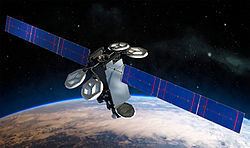Names IS-35e Spacecraft IS-35e Launch date 2017 Bus Boeing 702 | Launch mass 6 t (6.6 tons) Mission type Communications satellite | |
 | ||
Manufacturer Boeing Satellite Development Center Similar Intelsat 33e, Intelsat III F‑3, Intelsat 29e, Intelsat 36, Intelsat 5 | ||
Intelsat 35e, also known as IS-35e is a high throughput geostationary communications satellite ordered by Intelsat to be designed and manufactured by Boeing on the Boeing-702MP platform. It is slated to be the fourth satellite of the EpicNG service, and will cover the Americas, Europe and Sub-Sahara Africa from the 34.5°West longitude. It has a mixed C band and Ku band, with the C band featuring EpicNG spot beams.
Contents
Satellite description
Intelsat 35e is being designed and manufactured by Boeing on the Boeing 702MP satellite bus. It will have an estimated launch mass of 6 t (6.6 tons) and a design life of more than 15 years.
It is powered by two wings, with four panels each, of triple-junction GsAs solar cells. The 702MP platform was designed to generate between 6kW and 12kW.
It's payload will be the fourth high throughput EpicNG deployment. The EpicNG is characterized by the implementation of frequency reuse thanks to a mix of frequency and polarization in small spot beams. Not only applied to the classical HTS Ka band, but also applying the same technique in Ku band and C band. The EpicNG series also keep the use of wide beams to offer high throughput and broadcast capabilities in the same satellite.
In the case of Intelsat 35e, the C band side will have EpicNG spot beams with a total downlink bandwidth of 4,356 MHz. The spot beams offer high bandwidth for Europe, Sub-Sahara Africa, and the Americas. The Ku band has 39 transponder equivalent for a total downlink bandwidth of 1,404 MHz. The Ku three wide beams, one covering the Caribbean, another Europe and the Mediterranean and the third beams cover Europe and Northern Africa.
History
In July 2009, Intelsat became the first customer of the Boeing 702MP platform, when it place an order for four spacecrafts, Intelsat 21, Intelsat 22, Intelsat 27 and the first EpicNG satellite, Intelsat 29e. In May 2013, Intelsat made a second order for an additional four EpicNG satellites, the first of which would be Intelsat 33e. On July 8, 2014 Boeing announced a ninth 702MP order, and sixth EpicNG, for the Intelsat 35e.
During 2014, Intelsat announced to service contract where the clients would start using Intelsat 903 at the 34.5° West position, and then seamlessly transfer their services to Intelsat 35e as soon as it was commissioned into service.
During an interview with Intelsat's CEO Stephen Spengler on February 29, 2016, it was disclosed that Intelsat 35e was expected to launch in 2017. In August 2016, it emerged that the launch was assigned to a Falcon 9 Full Thrust mission scheduled for the first quarter of 2017. Performance improvements of the Falcon 9 vehicle family, now advertising 8,300 kg to GTO, enable the launch of this 6-tonne satellite without upgrading to a Falcon Heavy variant.
